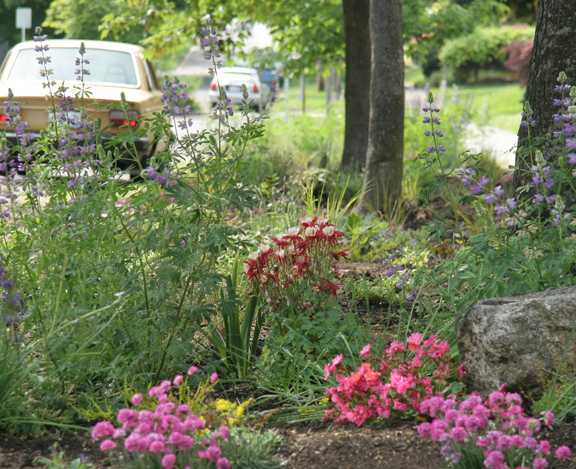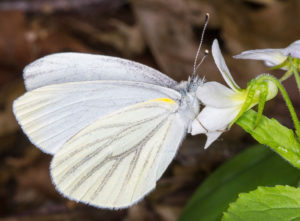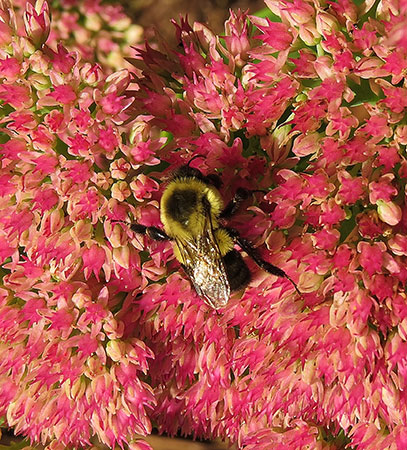Fluttering along the Pollinator Pathway
There’s the Silk Road, the Yellow Brick Road, and the road to you-know-where, which they say is paved with good intentions. We have the Appalachian Trail, also known as the Road to Divorce when people claim to be off hiking it but are in fact busy with extramarital affairs. But I digress. As usual. Our great country was built on highways, byways, boulevards, terraces, turnpikes, tow-paths, and bike paths. Now seems the right time to blaze a new kind of road.

Part of a pollinator pathway through a populated area. Photo: J from Seattle, Creative Commons, some rights reserved
Thanks to Seattle-based artist and environmentalist Sarah Bergmann, today we have the Pollinator Pathway. In 2008, Ms. Bergmann initiated what has been described as a “participatory art, design and ecology social sculpture” which she termed the Pollinator Pathway, a linear habitat to help pollinator insects find food as they wend their way through cities and other challenging landscapes. Since that time, the concept has spread to many parts of the U.S., and even other countries.
Pathways can be as simple as a line of flowering plants between one backyard and another, or as grand as a “flower belt” that connects green spaces across a major urban city. The Pollinator Pathway website has tools and resources, and lists major criteria such as the need to collaborate with various groups and agencies, use native plants primarily, and have a long-term maintenance plan. Like so many great ideas, the pollinator pathway notion has “gone wild,” and is being adopted by folks who are not always familiar with Ms. Bergmann’s work.
The idea is to establish plants of many colors and shapes which flower at all times of the growing season and at varying heights, so that the greatest variety of pollinating insects can take advantage of them. Presumably, non-insect pollinators are not part of these endeavors. Lemurs, lizards, bats, monkeys, opossums, and about 50 other vertebrate species also pollinate flowers, but attracting herds of such to wander about city neighborhoods might not be every urban planner’s dream.

Mustard White butterfly feeding on a Canada violet on the Butterfield Lake Trail. Archive Photo of the Day: Vici and Steve Diehl
Although the honeybee makes a great pollinator poster-child, in the larger scheme of things it contributes very little to the production of domestic and wild foods. In a healthy environment, and even in many compromised ones, it is the native moths, butterflies, wasps, bees, flies, beetles and other insects which do nearly all pollinating of wild and domestic crops. Certainly in a region like northern NY State, the impact of honeybees on pollination is negligible.
Not to say we shouldn’t still raise honeybees and be concerned about their health – honey and other bee products are important crops – but we should have a more accurate picture of who does our pollinating. Honeybees are essential in places where intensive agriculture has removed plants that native insects would normally depend upon, such as in California’s almond groves and even in some fruit-growing regions around the Great Lakes.
The reason pollinators are in so much danger that they require safe trails through cities and towns is complex, but has much to do with pesticides. A class of insecticides called neonicotinoids, or neonics for short, have long been implicated in pollinator decline. Used in everything from lawn-grub control to soybean production, these chemicals render an entire plant toxic, including its pollen. Bad news for insect pests, and also for bees and butterflies. In April 2018, the European Union banned three of the most popular neonics in order to protect bees.
And fungicides, once believed safe for bees, have recently been named as a suspect in pollinator decline. In a November 2017 report, a Cornell-led team of researchers from across the Northeast concluded that routine use of fungicides in agriculture weakens bees to the point they often succumb to bad weather or common diseases, factors which normally would not prove fatal. Today, 49 species of native bees are considered at risk, with bumblebees especially hard-hit.
If there was a pollinator prize, it would likely go to our fuzzy native bumblebee species. Hairiness is one reason bumblebees are more efficient pollinators than, say, yellow jackets, which by the way, contribute a fair bit to pollination. Another thing is that bumblers can operate at much colder temperatures than other insects—whether their wonderful fur coat helps with that I do not know. In addition, their “bumble” is part of their beauty. It turns out they vibrate the air at a Goldilocks frequency, one just right to shake loose pollen inside certain flowers such as tomatoes. In other words, they can do drive-by pollination without needing to land on the flower.
If you are not ready to mark out a pollinator superhighway, you can help make your community more bee and butterfly friendly by raising awareness about these issues, and by putting pressure on local officials to update zoning laws to allow more diverse landscapes in our towns and villages. Neat lawns are deadly to pollinators, so anything you can do to encourage diversity will help them out. For more information, visit http://www.pollinatorpathway.com or contact your local Cornell Cooperative Extension office.
Paul Hetzler is a horticulture and natural resources educator with Cornell Cooperative Extension of St. Lawrence County.
Tags: bees, butterflies, environment, moths, pollinators








